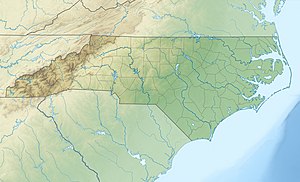Mears Fork is a 7.77 mi (12.50 km) long third order tributary to the Haw River, in Guilford County, North Carolina.
| Mears Fork Tributary to Haw River | |
|---|---|
| Location | |
| Country | United States |
| State | North Carolina |
| County | Guilford |
| Physical characteristics | |
| Source | divide between Mears Fork, Haw River, and Reedy Fork |
| • location | Summerfield, North Carolina |
| • coordinates | 36°12′32″N 079°53′57″W / 36.20889°N 79.89917°W[1] |
| • elevation | 878 ft (268 m)[2] |
| Mouth | Haw River |
• location | about 2 miles south of Midway, North Carolina |
• coordinates | 36°14′51″N 079°47′04″W / 36.24750°N 79.78444°W[1] |
• elevation | 699 ft (213 m)[2] |
| Length | 7.77 mi (12.50 km)[3] |
| Basin size | 12.59 square miles (32.6 km2)[4] |
| Discharge | |
| • location | Haw River |
| • average | 14.63 cu ft/s (0.414 m3/s) at mouth with Haw River[4] |
| Basin features | |
| Progression | Haw River → Cape Fear River → Atlantic Ocean |
| River system | Haw River |
| Tributaries | |
| • left | unnamed tributaries |
| • right | unnamed tributaries |
| Bridges | Strawberry Road, Lake Brandt Road, Cedar Ridge Farm Road |
Variant names
editAccording to the Geographic Names Information System, it has also been known historically as:[1]
- Mears Fork Creek
Course
editMears Fork rises on the divide between Mears Fork, Haw River, and Reedy Fork at Summerfield in Guilford County. Mears Fork then flows northeast to meet the Haw River about 2 miles south of Midway, North Carolina.[2]
Watershed
editMears Fork drains 12.59 square miles (32.6 km2) of area, receives about 45.7 in/year of precipitation, has a topographic wetness index of 409.05 and is about 50% forested.[4]
Natural History
editThe Natural Areas Inventory Guilford County, North Carolina and a later addition in 1995[5] recognized nine locations of natural significance in the Mears Fork watershed. These sites include:
- Witty Road Wetland (County General Significant)--the location of semi-impermanent impoundment and alluvial forest.
- Cummings Dairy Beaver Pond (County General Significant)--the location of a shrub swamp from an old beaver pond.
- Strader Road Beaver Pond (County General Significant)--the location of a beaver pond.
- Trailing Cedar Farm (County High Significant)--the location of wetland and forested communities with rare species.
- Burnt Oaks (County General Significant)--the location of beaver pond wetlands and forested slopes.
- Mears Fork at Lake Brandt Road (County High Significant)--the location of a mature Dry-Mesic Oak-Hickory Forest and Mesic Mixed Hardwood Forest.
- Cedar Hollow Alluvial Forest (County Low Significant)--the location of Piedmont Alluvial Forest.
- Mear Fork at Church Street (County General Significant)--the location of mature Dry-Mesic Oak-Hickory Forest.
- Church Street Ginseng Slope (County General Significant)--the location of a mature Mesic Mixed Hardwood Forest.
See also
editReferences
edit- ^ a b c "GNIS Detail - Mears Fork". geonames.usgs.gov. US Geological Survey. Retrieved 8 October 2019.
- ^ a b c "Mears Fork Topo Map, Guilford County NC (Lake Brandt Area)". TopoZone. Locality, LLC. Retrieved 8 October 2019.
- ^ "ArcGIS Web Application". epa.maps.arcgis.com. US EPA. Retrieved 8 October 2019.
- ^ a b c "Mears Fork Watershed Report". Waters Geoviewer. US EPA. Retrieved 8 October 2019.
- ^ "Natural areas inventory, Guilford County, North Carolina :: State Publications". digital.ncdcr.gov. Guilford County and North Carolina Natural Heritage Foundation. Retrieved 8 October 2019.
External links
edit

